- What’s the Difference Between a Job Description, Job Posting, and Job Ad - June 5, 2025
- Top 20+ Diversity Equity Inclusion Titles (with Descriptions) 2024 - October 18, 2024
- A List of Common Offensive (Exclusionary) Words Used in Job Descriptions (2024) - October 18, 2024
If you want your career site to attract and convert the best candidates, it helps to borrow lessons from the best storytellers.
Screenplay writers, for instance, are masters at getting us (the viewer) to sit down for:
- 2 days, 15 hours and 30 minutes (first 7 seasons of Game of Thrones)
- 22 hours and 40 minutes (all Star Wars movies)
- 4 days, three hours and 30 minutes to watch all nine seasons of The Office.
How great would it be to get top-tier talent to pay attention to YOU for that long!
There’s a terrific book called Building a StoryBrand that has some awesome tips. You should go read it. And Storybrand’s Donald Miller and J.J. Peterson also put on the terrific Storybrand podcast. I am not affiliated with their business. I’m just a fan. Thanks, Donald and J.J.
In the meantime, here are 5 storytelling tips/steps to help you transform your career site:
1. The Candidate is the Hero (Not You)
Many employers use their career home pages to beat their own chests. They’ll lead off with:
- “We’ve been in business for 50 years”
- “We’re the industry leader in XYZ widgets”
- “We’ve won XYZ awards”
That’s an ineffective approach to telling your story.
What you’re doing is treating yourself like the hero in the story.
The real hero is the candidate and you have to speak to them immediately.
They don’t care about you except for how you can “serve” or “guide” them.
You (the employer) must instead act as the “Guide” (see step 3 below).
The candidate hero is walking along through life thinking about their next moves.
To win them over, you need to talk first about THEM.
You can talk about YOU later.
Some tips on how to treat the candidate like the hero:
Hero Media Should Show the Candidate
Your media is important. It’s often the first thing a candidate looks at.
Since the hero is the candidate (who hopefully becomes an employee), you’re best bet is to show them in the hero media on your career page.
A tip that almost always works: show happy, smiling people like Pepsi below:
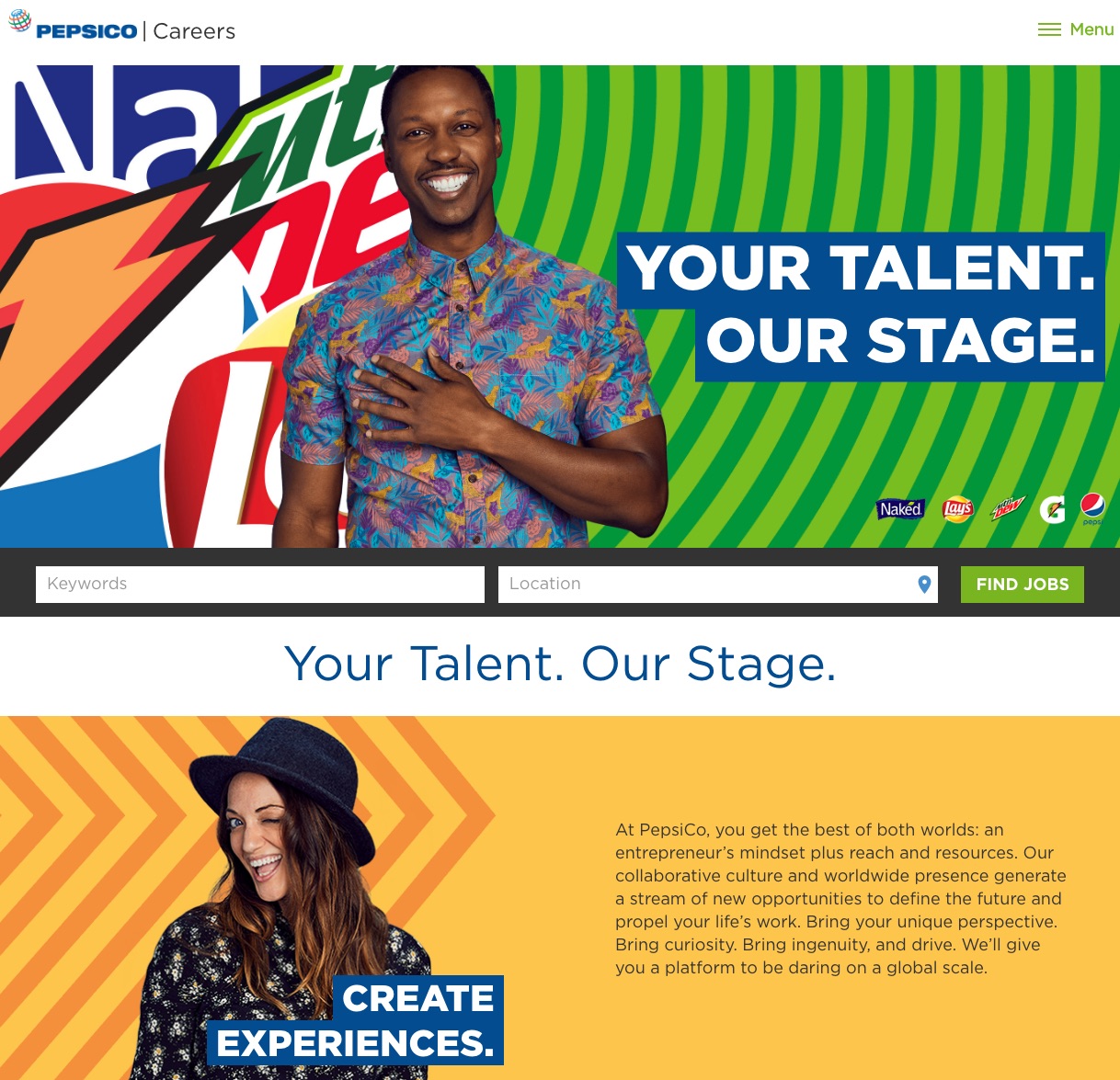
Use a Headline that Speaks to Exactly What a Candidate/Employee Gets
Next, you have to nail the headline/title.
Headlines help us figure out what’s going on. Afterall, most people are unlikely to:
- Open a book or magazine if it has no title
- Watch a movie without a title
- Listen to music without knowing the name of the song or band
Check out the headline for software leader SAS headline below.
“Your curiosity matters” is in the 2nd person (e.g. written to the candidate) and uses a quality SAS considers vital to candidates: “curiosity”.
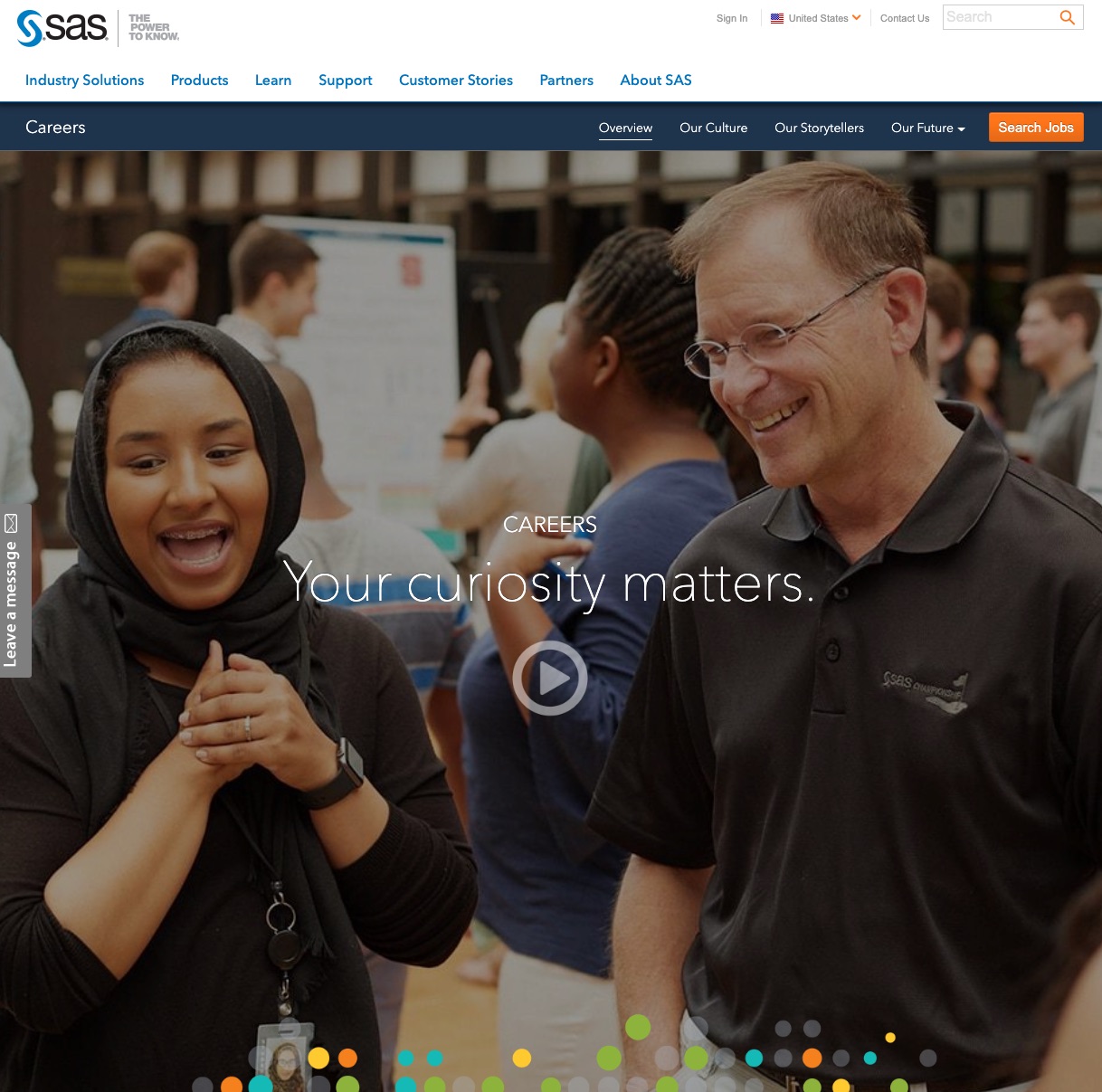
Everlane (below) uses a few more qualifying words in their career page headline:
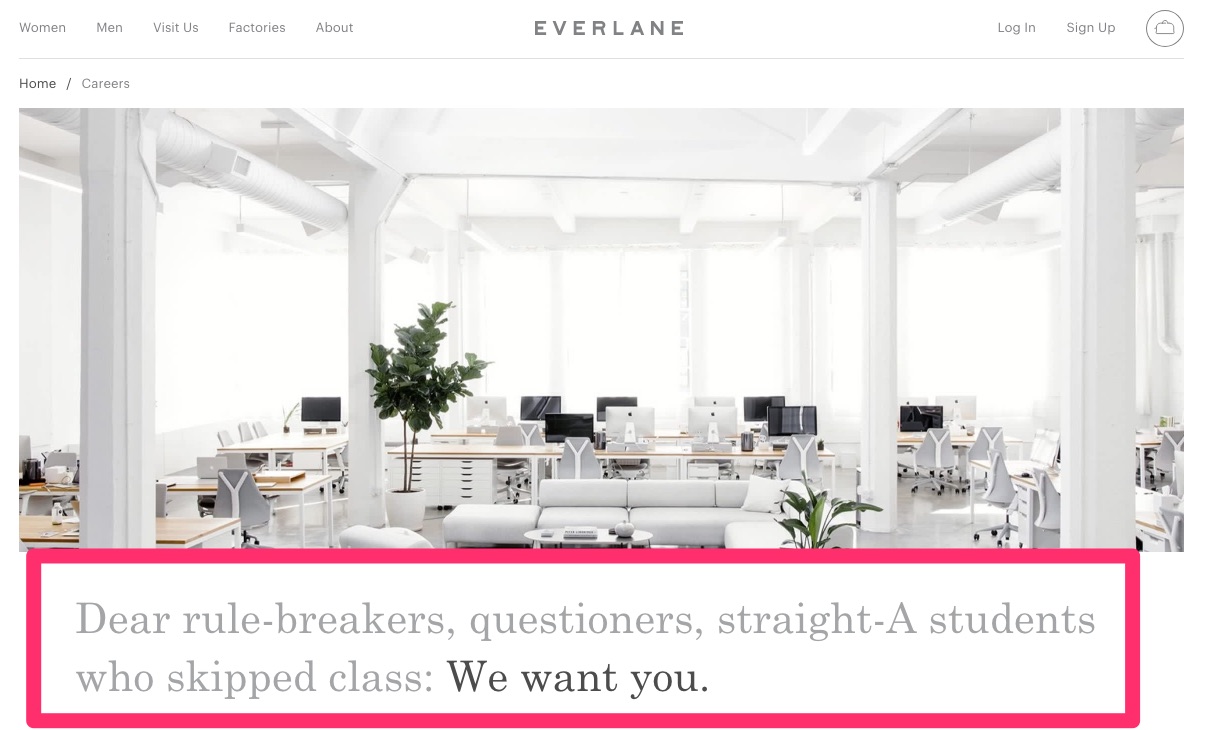
Other good, candidate-centric headlines include:
- Facebook (“Do the Most Meaningful Work of Your Career”)
- McClatchy (“Make a Difference”)
- ABInBev (“Opportunities Around the World”)
- Proctor & Gamble'(“Make an Impact on More than Just Your Career”).
See how those headlines differ from the career home page headline of many employers which is typically something like?:
“Careers at [Company Name]” or “Jobs at [Company Name]”
2. Focus on the Candidate/Hero’s “Problem”
Ok, the candidate is the hero in the story. And in every good story, the hero has a problem.
In the movies, the hero’s problem is usually something very dramatic like beating the Nazis to find an artifact (Raiders of the Lost Ark)) or fighting the dark side (Star Wars).
A candidate’s problem might not be as dramatic but it’s surely vital to them. A candidate’s problem is likely around categories such as:
- Family (they want one or want to protect one)
- Health (theirs and perhaps their family)
- Power/responsibilities (they want to grow their career)
- Connections with people (they want to meet new friends)
- Time/Flexibility (they want it to spend more time with family or on a side-passion)
- Money
- Fulfillment (they want to lead a purposeful life)
Surely you can help solve some of those problems!
Easy tip: Just answer the question “Why?”…as in why should the candidate join you. This can be simple. Check out AAA’s list of 4 categories of value they provide to candidates who get a job there.
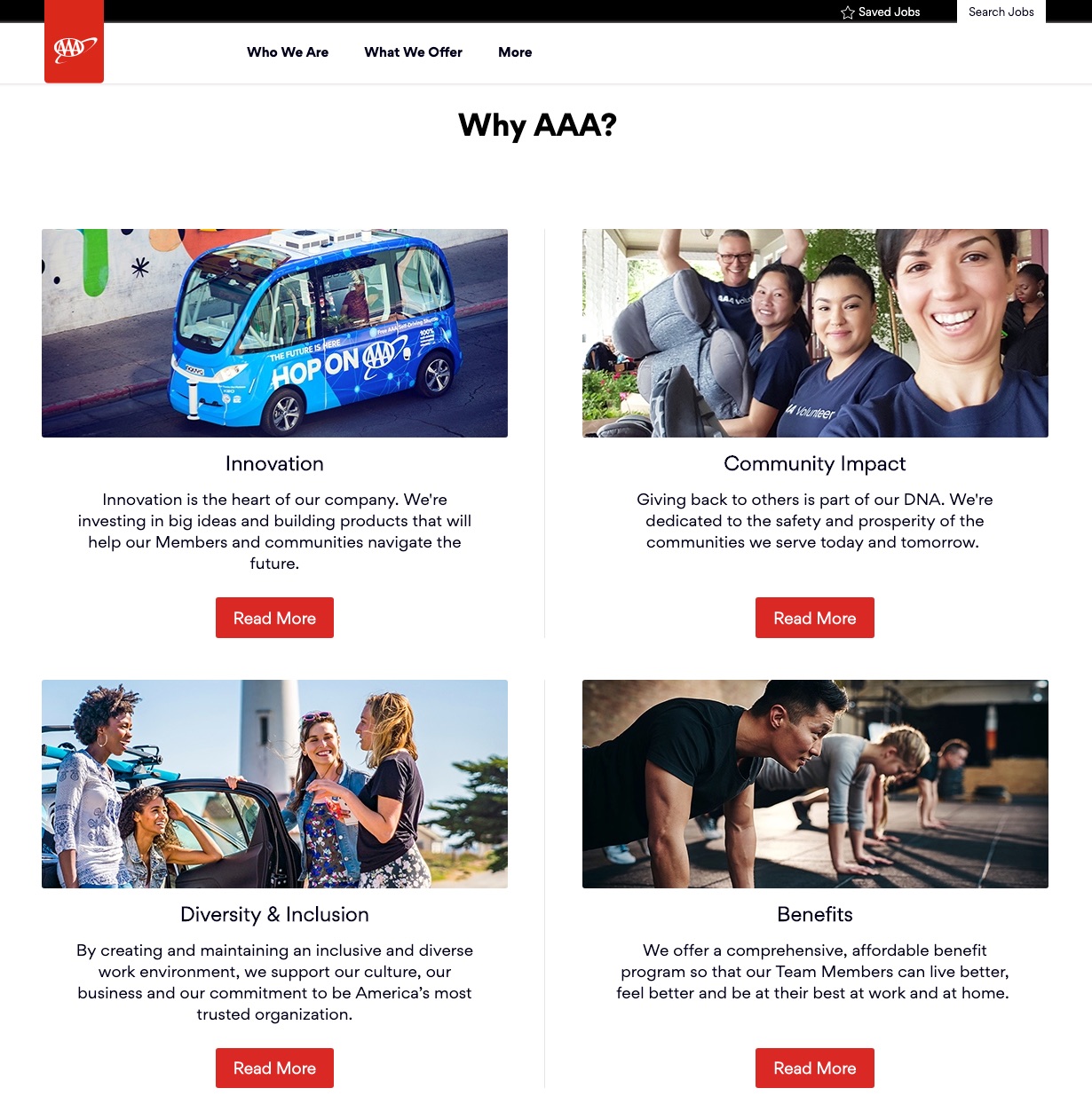
Here are some specific ideas for you to include on your career home page that speak to the problem that your hero candidate might be hoping you’ll help solve:
- Family — show a picture of family attending a work event
- Health — list out your health benefits, show fitness if you offer it!
- Power/responsibilities — list out a career path of a job or show a testimonial of someone who rose up through the ranks
- Connections — show groups of happy people together
- Time/Flexibility — emphasize your multiple locations and any options to work from home or part-time
- Money — mention compensation somewhere (it could as simple as “competitive salary” in a list of benefits or you could use 3rd party salary sources such as Glassdoor, Comparably, etc.
- Fulfillment — Mention anything you do to help the candidate/employee grow to grow their self-esteem.
This pyramid below that we created for a past article might be helpful in helping you envision the types of needs candidates have:
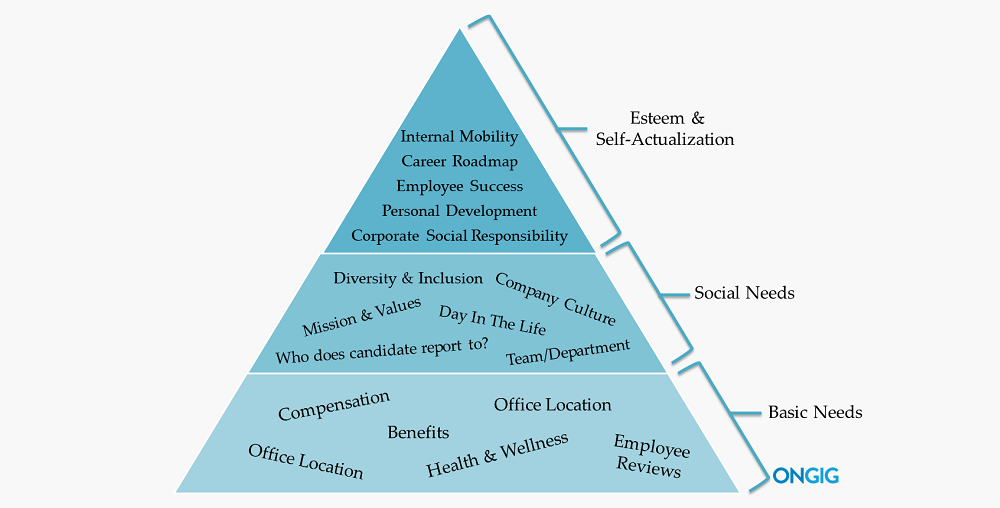
3. The Guide (that’s you!)
Remember how in Step 1, we told you that you are not the hero? That’s because you the employer (or talent leader) are the guide.
And the Guide is an awesome role! Examples of guides in famous movies are:
- Obi-Wan Kenobi and Yoda to Luke Skywalker
- Haymitch to Katniss or
- Dumbledore to Harry Potter
- Gandalf to Frodo
The main job of you the Guide is to give your candidate (the hero) a plan to solve their problems.”
4. The Plan
Your first job as the Guide (aka employer/talent leader/recruiter) is to give the candidate a plan to help them solve their problem(s).
Obi-Wan Kenobi’s plan for Luke Skywalker was to teach him to be a jedi and use “the force”.
On a company career site, the plan you want to give is:
- An easy way to understand what you the employer does and whether it’s for them
- An easy way to find job opportunities and clear way to apply (see “call-to-action” below)
- An explanation of what happens after they apply (e.g. the interview process)
- A career path they might enjoy
5. The Call to Action
You want the hero (candidate) to take action. In Star Wars, Luke Skywalker’s call-to-action is to go help Princess Leia.
For your career site, I recommend that your call-to-action to candidates be to “find” or “search” for a job (i.e. job search).
Tips on a good candidate call-to-action:
- It should be above-the-fold on the screen (the candidate should see it without scrolling)
- It should pass the “Squint Test” — if you look at your career home page and squint, the call-to-action button should stand out. The best employers use a different color for the “job search” button (like BRP below).
- Button — People are used to pressing things to get what they want. When in doubt, use a button for the call-to-action.
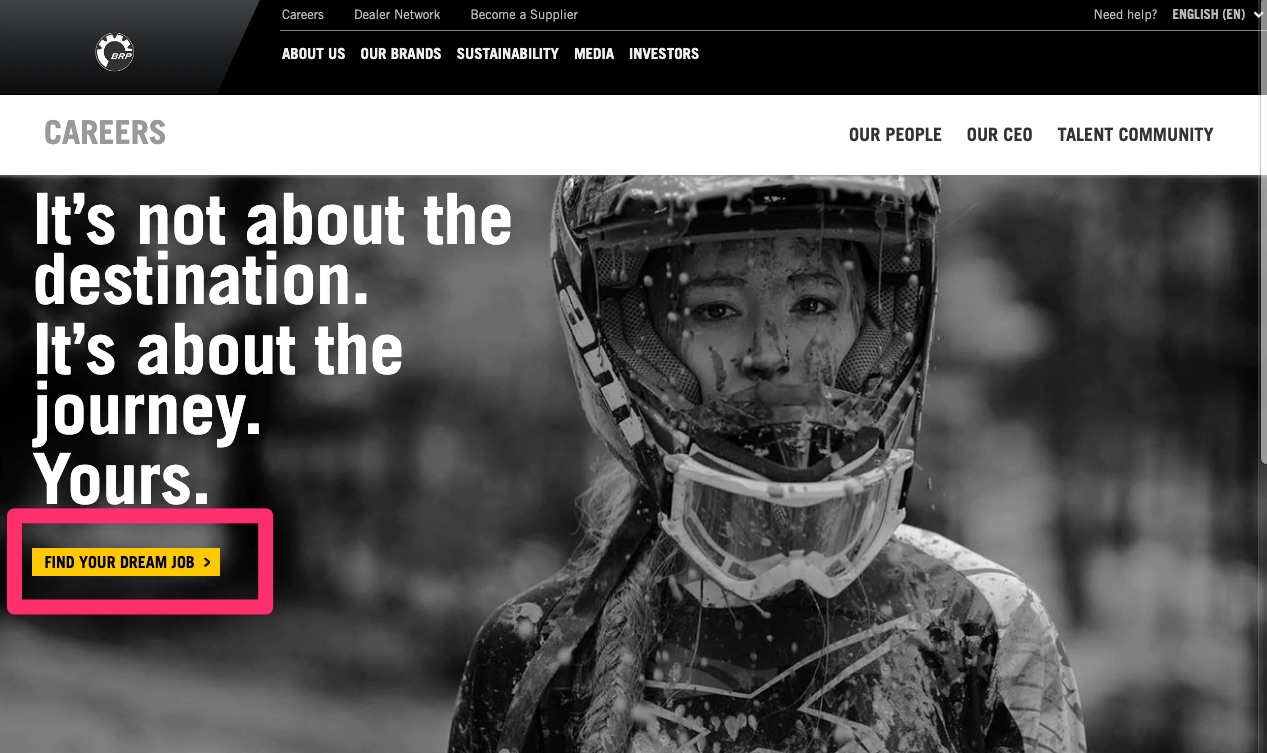
The only reason you would want to use a call-to-action other than “Search/Find a Job” would be if you were trying to establish a new brand. In that case, you might want to ask the candidate to watch a video first to hear your story.
Many employers will also use their career pages for a second call-to-action. An example of this is to ask the candidate to join your talent community.
At the end of the day, you want quality candidates to apply for a job. But your first call-to-action is to get them to LOOK at your jobs
Why I wrote this?
We’re on a mission to transform job pages to get you more attention and engagement. We beg, steal and borrow many techniques from the best storytellers of the world to do this…and then we build it into Ongig’s job description software. I really do love this stuff. Ping me if you’d like a demo.
